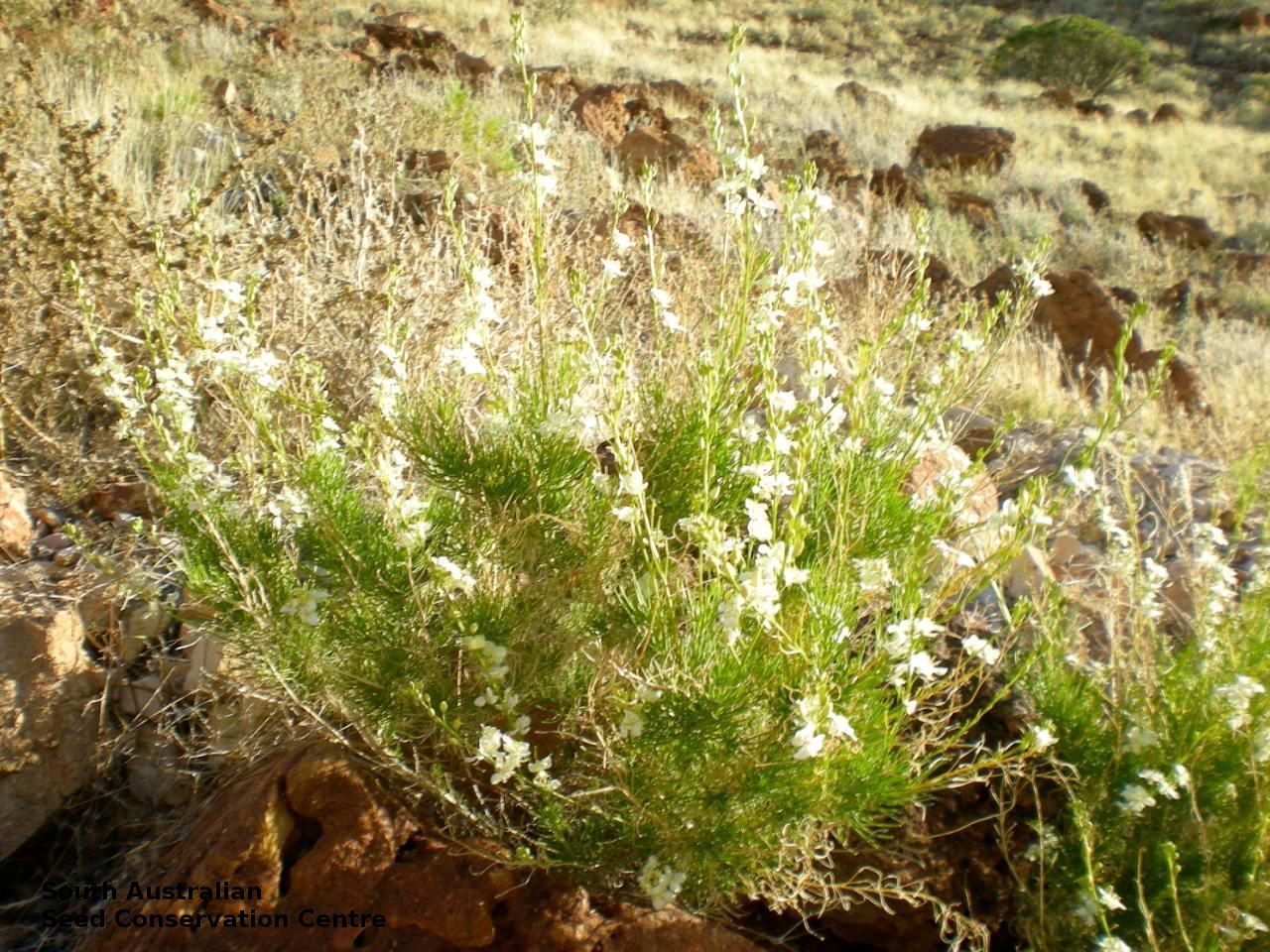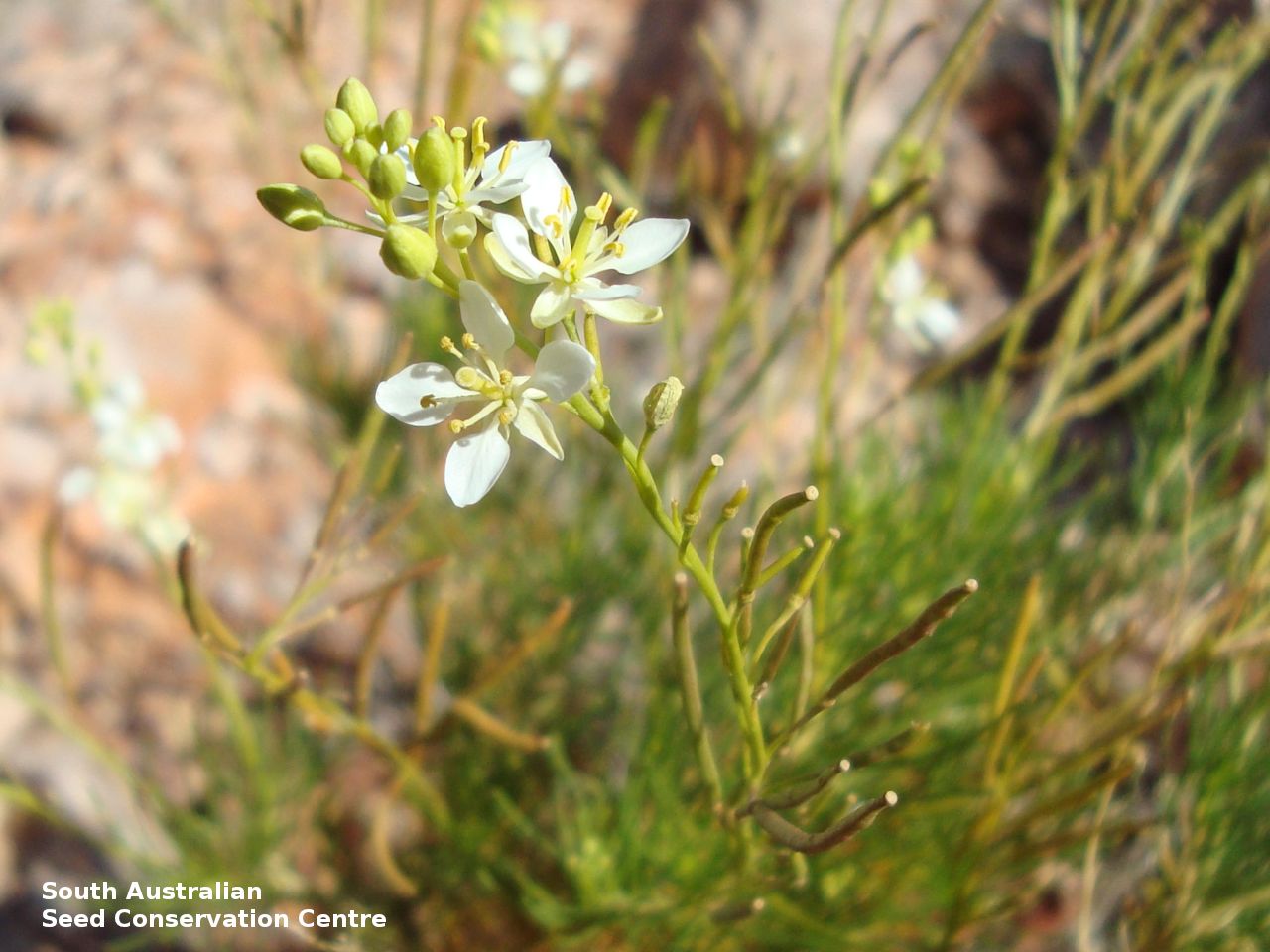Shrubby cress,
Native Stock
Display all 17 images

















Regional Species Conservation Assessments per IBRA subregion.


Least concern
Near threatened
Rare
Vulnerable
Endangered
Critically endangered
Extinct
Data deficient
Adelaide
Arkaroola
Ceduna
Coober Pedy
Hawker
Innamincka
Marla
Marree
Mount Gambier
Oodnadatta
Renmark
Wudinna
Keith
Yunta
Display IBRA region text
| Kangaroo Island (KAN01) | Kanmantoo | Data Deficient [questionable occurrence, more arid sp] |
| Broughton (FLB02) | Flinders Lofty Block | Vulnerable (IUCN: VU B2ab(i,ii,iii)) (Probable Decline) [no recent records] |
| Olary Spur (FLB03) | | Least Concern |
| Southern Flinders (FLB04) | | Vulnerable (IUCN: VU B2ab(i,ii,iii)) (Probable Decline) [no recent records] |
| Northern Flinders (FLB05) | | Least Concern [likes rocky outcrops] |
| Central Flinders (FLB06) | | Least Concern [likes rocky outcrops] |
| Eyre Hills (EYB03) | Eyre Yorke Block | Rare (IUCN: RA d(i,ii)) (Probable Decline) |
| South Olary Plain (MDD01) | Murray Darling Depression | Least Concern |
| Murray Mallee (MDD02) | | Rare (IUCN: RA d(i,ii)) [edge of range] |
| Braemer (MDD07) | | Least Concern |
| Murray Scroll Belt (RIV06) | Riverina | Rare (IUCN: RA d(i,ii)) [edge of range] |
| Myall Plains (GAW01) | Gawler | Least Concern |
| Gawler Volcanics (GAW02) | | Least Concern |
| Gawler Lakes (GAW03) | | Least Concern |
| Arcoona Plateau (GAW04) | | Least Concern |
| Kingoonya (GAW05) | | Least Concern |
| Torrens (GAW06) | | Near Threatened |
| Roxby (GAW07) | | Least Concern [likes rocky outcrops] |
| Maralinga (GVD03) | Great Victoria Desert | Rare (IUCN: RA d(i,ii)) |
| Yellabinna (GVD06) | | Rare (IUCN: RA d(i,ii)) [limited habitat] |
| Nullarbor Plain (NUL02) | Nullarbor | Least Concern |
| Yalata (NUL03) | | Rare (IUCN: RA d(i,ii)) [limited habitat] |
| Barrier Range (BHC01) | Broken Hill Complex | Least Concern |
| Barrier Range Outwash (BHC04) | | Least Concern |
| Bimbowrie (BHC05) | | Least Concern |
| Curnamona (BHC06) | | Least Concern |
| Breakaways (STP01) | Stony Plains | Least Concern [likes rocky outcrops] |
| Murnpeowie (STP03) | | Least Concern [likes rocky outcrops] |
| Peake-Dennison Inlier (STP04) | | Least Concern [likes rocky outcrops] |
| Witjira (STP06) | | Near Threatened |
| Baltana (STP07) | | Least Concern [likes rocky outcrops] |
| Sturt Stony Desert (CHC02) | Channel Country | Least Concern [likes rocky outcrops] |
| Mann-Musgrave Block (CER01) | Central Ranges | Least Concern [likes rocky outcrops] |
| Everard Block (CER03) | | Least Concern [likes rocky outcrops] |
| Tieyon (FIN03) | Finke | Near Threatened |
| Kangaroo Island (KAN01) | Kanmantoo | Data Deficient [questionable occurrence, more arid sp] |
| 5 of 6 subregions | Flinders Lofty Block | Least Concern , Vulnerable |
| Eyre Hills (EYB03) | Eyre Yorke Block | Rare (IUCN: RA d(i,ii)) (Probable Decline) |
| 3 of 6 subregions | Murray Darling Depression | Least Concern , Rare |
| Murray Scroll Belt (RIV06) | Riverina | Rare (IUCN: RA d(i,ii)) [edge of range] |
| 7 of 8 subregions | Gawler | Least Concern , Near Threatened |
| 2 of 4 subregions | Great Victoria Desert | Rare |
| 2 of 3 subregions | Nullarbor | Least Concern , Rare |
| 4 of 4 subregions | Broken Hill Complex | Least Concern |
| 5 of 7 subregions | Stony Plains | Least Concern , Near Threatened |
| Sturt Stony Desert (CHC02) | Channel Country | Least Concern [likes rocky outcrops] |
| 2 of 3 subregions | Central Ranges | Least Concern |
| Tieyon (FIN03) | Finke | Near Threatened |
Botanical art
Kath Alcock paintings: 3
Prior names
Erysimum trisectum
Arabidella trisecta var. hybophora
Sisymbrium trisectum
Blennodia trisecta
Common names
Shrubby cress
Native Stock
Etymology
Arabidella a diminutive of 'arabis' which is a Greek word for mustard or cress. Trisecta from the Latin 'treis' meaning three and 'sectus' meaning divided, referring to the three-divided leaves.
Distribution and status
Found across much of South Australia except on the Yorke Peninsula, Kangaroo Island, southern Mount Lofty Ranges and the South-east, growing in a variety of habitats in disurbed areas, especially on loam, clay or rocky soils. Also found in all mainland States. Native. Common in South Australia. Common in the other States.
Herbarium regions: North Western, Lake Eyre, Nullarbor, Gairdner-Torrens, Flinders Ranges, Eastern, Eyre Peninsula, Northern Lofty, Murray
NRM regions: Alinytjara Wilurara, Eyre Peninsula, Northern and Yorke, South Australian Arid Lands, South Australian Murray-Darling Basin
AVH map: SA distribution map (external link)
Plant description
Erect woody perennial shrub to 60 cm tall; bright green in appearance. Leaves bi- or trisected to 4 cm long with linear segments. Flowers are white or yellow on a long spike. Flowering between June and October. Fruits are long brown cylindrical pods on a long spike. Seeds are small yellow semi-flat reniform seeds to 1.2 mm long and 0.7 mm wide. Seed embryo type is bent.
Seed collection and propagation
Collect seeds between August and December. Collect pods that are maturing, drying off and turning brown, with yellow seeds inside. Place the pods in a tray and cover with paper to prevent seeds from popping out and leave to dry for a week. Then rub the pods gently by hand to dislodge the seeds. Use a sieve to separate the unwanted material. Store the seeds with a desiccant such as dried silica beads or dry rice, in an air tight container in a cool and dry place. From one collection, the seed viability was high, at 100%. This species has physiological dormancy that need to be overcome for the seed to germinate.
| Location | No. of seeds
(weight grams) | Number
of plants | Date
collected | Collection number
Collection location | Date
stored | % Viability | Storage
temperature | BGA
MSB | 10,800 (2.06 g)
10,800 (2.06 g) | 15 | 28-Aug-2008 | DJD1148
Lake Eyre | 20-Jul-2009 | 100% | -18°C |
Location: BGA — the seeds are stored at the Adelaide Botanic Gardens, MSB — the seeds are stored at the Millennium Seed Bank, Kew, England.
Number of plants: This is the number of plants from which the seeds were collected.
Collection location: The Herbarium of South Australia's region name.
% Viability: Percentage of filled healthy seeds determined by a cut test or x-ray.
Germination table:
Display
















